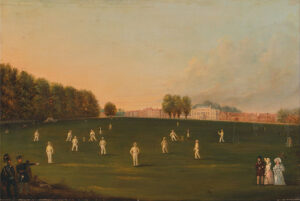Baseball, often referred to as America’s pastime, is a sport that has captured the hearts and imaginations of millions. It is a game steeped in tradition, with its origins shrouded in mystery and debate. For years, scholars and enthusiasts alike have grappled with the question: who invented baseball?
In this article, we will explore the early origins of ball-and-bat games and examine the two prevailing theories surrounding the invention of baseball – the Doubleday myth and the Cartwright theory. We will delve into the evolution of baseball rules, paying particular attention to the contributions of the Knickerbocker Base Ball Club. Additionally, we will investigate how rounders and cricket influenced this beloved sport.
Furthermore, we will explore how baseball spread across the United States and discuss its growth as a professional sport. Finally, we will highlight baseball’s continued evolution and enduring popularity today. Through an evidence-based approach rooted in thorough research, this article aims to shed light on one of sports’ most intriguing questions – who truly invented baseball?
Key Takeaways of Who Invented Baseball?
- The origins of baseball are unclear and there is no evidence to support the Doubleday myth of Abner Doubleday inventing baseball.
- Baseball evolved from various ball-and-bat games played in England and North America, with the Cartwright Theory suggesting that Alexander Cartwright formalized the rules of baseball.
- The Knickerbocker Base Ball Club made significant contributions to the development of baseball, introducing innovations such as nine players on each team and three outs per inning.
- Rounders and cricket played a significant role in shaping the development of baseball, influencing batting techniques, base-running strategies, and fielding positions.
Early Origins of Ball-and-Bat Games
The early origins of ball-and-bat games can be traced back to ancient civilizations such as Egypt and Persia. Historical evidence suggests that these cultures engaged in bat-and-ball activities as early as 2000 BCE.
In Egypt, a game called ‘seker-hemat’ involved players hitting a small ball with a wooden stick. Similarly, the Persian game of ‘nafas’ used a bat-like instrument to strike a ball made of animal hide. These early forms of ball-and-bat games demonstrate the long-standing fascination with this type of sport across different societies throughout history.
Transitioning into the subsequent section about the ‘Doubleday myth,’ it is important to critically examine how baseball’s invention has been attributed to specific individuals or events. While there are claims that Abner Doubleday invented baseball in Cooperstown, New York in 1839, historical evidence does not support this assertion.
The Doubleday Myth
Contrary to popular belief, the supposed involvement of Abner Doubleday in the creation of baseball has been widely debunked, with historical evidence pointing to its development as a collective effort rather than the result of a single individual’s ingenuity.
The Doubleday controversy emerged in the 20th century when an article by Albert Spalding claimed that Doubleday invented baseball in Cooperstown, New York, in 1839. However, subsequent research and analysis have revealed that there is no concrete evidence linking Doubleday to the origins of baseball.
Instead, it is now widely accepted that baseball evolved from various ball-and-bat games played in England and North America during the 18th and early 19th centuries. These games included rounders, cricket, town ball, and other similar sports.
Thus, attributing the invention of baseball solely to Abner Doubleday is a myth unsupported by historical documentation or factual evidence.
Moving forward to explore another theory regarding the true origins of baseball.
The Cartwright Theory
According to the Cartwright Theory, baseball’s origins can be traced back to various ball-and-bat games played in England and North America during the 18th and early 19th centuries. These early ballgames, such as rounders in England and town ball in North America, laid the foundation for what would eventually become modern baseball.
Alexander Cartwright is often credited with formalizing the rules of baseball in 1845 when he established the Knickerbocker Base Ball Club in New York City. However, it is important to note that Cartwright did not invent the game from scratch but rather codified existing practices and added a few new rules.
The Cartwright Theory provides a strong argument for baseball’s evolution from earlier ball-and-bat games, setting the stage for further developments in the sport’s history. This transition into exploring the evolution of baseball rules highlights how these early influences shaped its development over time.
The Evolution of Baseball Rules
One significant aspect of baseball’s development is the gradual evolution of its rules, which were shaped by a combination of cultural influences and practical considerations. As the game evolved over time, so did its equipment.
In the early years, players used homemade wooden bats and hand-stitched balls made from rubber or cork. However, advancements in technology led to the introduction of standardized equipment such as metal bats and synthetic balls. These changes not only affected the gameplay but also influenced strategies and tactics employed by teams.
Moreover, rule changes played a crucial role in shaping the game of baseball. For instance, the introduction of foul territory allowed for more strategic field placements and defensive plays. The implementation of fair/foul rules for hits improved scoring opportunities while adding excitement to the game. Similarly, regulations regarding stealing bases added an element of speed and strategy to gameplay.
As baseball’s rules evolved alongside advancements in technology and strategy, it became a more complex and engaging sport. This set the stage for further innovations such as those pioneered by the Knickerbocker Base Ball Club.
The Knickerbocker Base Ball Club
The Knickerbocker Base Ball Club, a prominent team in the mid-19th century, made significant contributions to the development of the sport through their innovative rules and strategies. As one of the first organized baseball teams, they played a crucial role in shaping the origins of baseball. The club was founded in 1845 by Alexander Cartwright and several other members who sought to formalize the game and establish a set of rules. They introduced many key elements that are still present in modern-day baseball, including nine players on each team, baselines at right angles, and three outs per inning. Their rulebook, known as the “Knickerbocker Rules,” provided a solid foundation for future iterations of the game.
To better understand the impact of their contributions, consider the following table:
| Rule or Strategy | Description |
|---|---|
| Nine Players | The Knickerbockers established nine players on each team, which remains standard today. |
| Baselines at Right Angles | They introduced baselines running at right angles from home plate to first base and third base. |
| Three Outs per Inning | The club implemented three outs per inning instead of four or five as seen in earlier versions. |
These innovations laid the groundwork for what would eventually become modern baseball.
Transitioning into Alexander Cartwright and his influence on ‘the New York Game,’ we can delve into further details about his impact on shaping baseball’s evolution without missing a beat
Alexander Cartwright and the New York Game
Alexander Cartwright, a key figure in the development of baseball, played a pivotal role in shaping the evolution of the sport known as ‘the New York Game’, leaving an indelible mark on its history.
The invention controversy surrounding baseball has long been debated, with various theories attributing its origin to different individuals and locations. However, Cartwright’s contribution to the game cannot be denied.
He was a member of the Knickerbocker Base Ball Club and is often credited with formalizing many of the rules that are still followed in modern baseball. Cartwright codified the diamond-shaped field, set bases at 90 feet apart, and established nine players per team. His efforts laid a strong foundation for baseball’s development and influenced its subsequent growth.
Moving forward, it is important to consider how rounders and cricket also shaped the sport without discounting Cartwright’s significant role.
The Influence of Rounders and Cricket
Rounders and cricket, two popular bat-and-ball games, played a significant role in shaping the development of the sport now known as baseball. Both games were widely played in England and brought to North America by early settlers.
Rounders, which dates back to at least the 16th century, shares several similarities with modern baseball. It involves batting, running between bases, and fielding. Similarly, cricket, a game that originated in England in the 18th century, features striking a ball with a bat and scoring runs by running between wickets.
The influences of rounders and cricket on modern baseball are apparent through shared elements such as batting techniques, base-running strategies, and fielding positions. The concept of innings also comes from cricket. These games provided a foundation upon which early American versions of baseball were built.
Transition: With the establishment of these foundational aspects from rounders and cricket, it is now important to examine how baseball spread across the United States without missing a beat.
The Spread of Baseball Across the United States
One of the key factors in the rapid diffusion of baseball across the United States was its integration into the military culture during the American Civil War. Soldiers from different regions played baseball during their downtime, which allowed them to share and spread the sport to new areas.
The early origins of baseball can be traced back to various ball games such as rounders and cricket, which were popular in England. As soldiers returned home, they brought their love for the game with them, introducing it to their communities and establishing local teams. Baseball quickly gained popularity as a recreational activity and soon became an organized sport with leagues forming in different states.
This grassroots movement, fueled by soldiers’ enthusiasm for baseball, contributed significantly to its widespread adoption throughout America. Transitioning into ‘the role of professional baseball players’, this initial wave laid a solid foundation for future developments in the sport.
The Role of Professional Baseball Players
The spread of baseball across the United States was greatly influenced by the role of professional baseball players. These players not only showcased their skills on the field but also played a pivotal role in popularizing the sport and attracting fans. One aspect that contributed to their influence was the rise of salaries in professional baseball, which attracted talented athletes from various backgrounds. The increasing salaries not only provided financial security for players but also made baseball a viable career option, leading to a larger pool of talented individuals entering the sport. Furthermore, professional baseball players had a significant impact on local economies as well. Their presence in cities brought in revenue through ticket sales, merchandise, and tourism, boosting local businesses and creating jobs. This economic impact further solidified the importance of professional baseball within American society.
| Player | Team | Salary (per year) |
|---|---|---|
| Babe Ruth | New York Yankees | $80,000 |
| Jackie Robinson | Brooklyn Dodgers | $35,000 |
| Hank Aaron | Atlanta Braves | $200,000 |
| Derek Jeter | New York Yankees | $21 million |
| Mike Trout | Los Angeles Angels | $37 million |
The role played by professional baseball players in popularizing and economically benefiting from this sport continues today with even higher salaries and broader global appeal.
Baseball’s Continued Evolution and Popularity Today
Baseball’s enduring evolution and sustained popularity can be attributed to its continual adaptation to changing societal and technological dynamics, which has allowed the sport to remain relevant and captivating for fans across generations.
The following list highlights the evolutionary changes and cultural impact that have contributed to baseball’s continued success:
- Technological advancements: From the introduction of instant replay to advanced analytics, technology has enhanced the game by providing more accurate decision-making and deeper insights into player performance.
- Expansion of international talent: Baseball’s globalization has brought in players from diverse backgrounds, enriching the sport with different playing styles and cultural influences.
- Fan engagement initiatives: Major League Baseball has implemented various strategies such as social media campaigns, interactive experiences at stadiums, and fantasy leagues to keep fans engaged and connected.
- Media coverage: The widespread availability of televised games, online streaming platforms, sports websites, and podcasts allows fans worldwide to follow their favorite teams closely.
These evolutionary changes have not only kept baseball relevant but also expanded its reach globally while maintaining a deep-rooted connection with its passionate fan base throughout history.
Frequently Asked Questions
How did the invention of baseball impact other sports like rounders and cricket?
The invention of baseball had a significant impact on other sports like rounders and cricket. It led to an increase in popularity and cultural significance, as it introduced new rules, strategies, and equipment that influenced the evolution of these sports.
What were the major differences between the early origins of ball-and-bat games and the modern game of baseball?
The modern game of baseball differs significantly from its early origins in terms of rules, equipment, and gameplay. These differences can be traced back to the various ball-and-bat games that existed before baseball’s formalization as a sport.
How did the Knickerbocker Base Ball Club contribute to the development of baseball?
The Knickerbocker Base Ball Club, through their rules and organization, laid the foundation for modern baseball. Their contribution impacted other sports by influencing the development of standardized rules and promoting team play.
What role did Alexander Cartwright play in the evolution of the New York Game?
Alexander Cartwright played a significant role in the evolution of the New York game, making contributions to its rules and establishing the Knickerbocker Base Ball Club. His influence led to the spread of baseball across the United States, impacting other sports like rounders and cricket. Early ball and bat games differed from modern baseball in various ways.
How did baseball spread across the United States and become a popular sport?
Baseball spread across the United States and became a popular sport through various factors. Its cultural significance and impact on American society can be attributed to its growth as a professional game, technological advancements, media coverage, urbanization, and societal changes.
Conclusion
In conclusion, the origins of baseball have been a subject of much debate and speculation. Despite various theories surrounding its invention, there is no concrete evidence to definitively attribute the creation of baseball to any individual or group.
Through the years, baseball has evolved and gained immense popularity across the United States and beyond. Its continued growth and evolution are a testament to its timeless appeal and enduring legacy.
As we unravel the mysteries of baseball’s past, we are left with an exhilarating sense of curiosity about its true origins, making it all the more captivating and intriguing for both players and fans alike.






